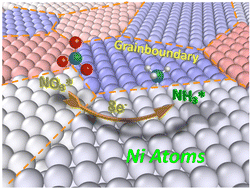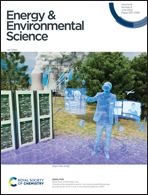Regulating active hydrogen adsorbed on grain boundary defects of nano-nickel for boosting ammonia electrosynthesis from nitrate†
Abstract
The electrochemical nitrate reduction reaction (NitRR) into ammonia is a promising route for sustainable ammonia synthesis under ambient conditions. Since the hydrogen evolution reaction (HER) is its main competing reaction, many researchers apply materials (e.g., copper-based materials) which are inert in water splitting for enhancing the conversion efficiency of nitrate into ammonia. The HER active metals (e.g., nickel) are usually considered unsuitable for such applications. However, the NitRR relies strongly on H* which is produced from water splitting, and HER active metals such as Ni can produce massive H* for the consumption of the intermediates. Therefore, HER active metals could be promising candidates for the NitRR if the destination of H* can be well regulated, but this has not been well investigated. Herein, a strategy of grain boundary (GB) defect engineering of nickel nanoparticles has been developed to electrocatalyze the NitRR, which achieves a high NH3 rate of 15.49 mmol h−1 cm−2 with a faradaic efficiency of 93.0%. This NH3 rate, to the best of our knowledge, is much higher than those reported for the commonly used materials including copper or noble metal-based catalysts. Both experimental and computational simulation results reveal that the GBs can significantly suppress the HER by regulating the H* to favor its consumption in the NitRR pathway rather than forming hydrogen. The adsorption of NO3* can also be promoted, thus effectively enhancing the key rate-determining step of NO3* to NO2*.



 Please wait while we load your content...
Please wait while we load your content...